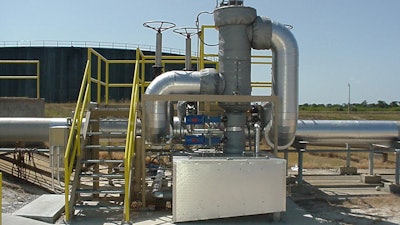
Various industries including wastewater treatment, power generation, food processing and chemical manufacturing depend on industrial strainers to separate unwanted suspended solids from liquids and slurries. However, conventional strainer methods can prove to be unreliable and lead to extensive maintenance, particularly in cases where the debris or solids are of substantial size and there is a significant amount of suspended solids present.
Fortunately, the utilization of a novel blend of industrial wastewater technologies now allows for the efficient removal of solids without the need for extensive manual labor, worker exposure to messy or potentially hazardous substances or constant maintenance. Specifically, the design involves a one-two punch combination of a macerator, which breaks down large solids into smaller fragments and an automated scraper strainer flexible enough to efficiently filter out larger debris along with tiny particles. This innovative solution can even accommodate high solids loading without clogging.
The combination of these two established technologies is already being applied to some of the toughest, dirtiest straining applications including wastewater debris, power plant boiler water slag, asphalt transloading and meat processing waste streams.
 An automated scraper strainer like that from Acme Engineering is designed to continually remove both very large and very small suspended solids from liquids and slurries.Acme Engineering Prod., Inc.
An automated scraper strainer like that from Acme Engineering is designed to continually remove both very large and very small suspended solids from liquids and slurries.Acme Engineering Prod., Inc.
Overcoming Traditional Limitations
Duplex strainers are often used in continuous flow processes that cannot be shut down for cleaning purposes. Duplex basket strainers employ two distinct chambers that function independently. When one chamber needs cleaning, the flow is seamlessly diverted to the alternate chamber, enabling the removal and cleaning of the first basket.
Cleaning is a messy, laborious process that involves equalizing pressure between the baskets, diverting flow to the off-line chamber, opening the cover, manually removing the clogged basket and cleaning it before refitting the basket, ensuring the seal and tightening the fasteners.
If an operator fails to adequately clean the basket strainers for any reason, both strainers can become clogged at the same time. This compromises the filtration process, resulting in quality issues or unexpected downtime until the problem is resolved. For many processors, this can occur simply due to having insufficient personnel to keep basket strainers clean along with their other duties.
“As an alternative, a combination of established complimentary technologies such as a macerator and an automated scraper strainer can essentially ‘knock out’ even the toughest problems related to large solids and high solids loading in an automated way,” said Robert Presser, Vice President of Acme Engineering Prod., Inc., a North American manufacturer of industrial self-cleaning strainers. The company is an ISO 9001:2015 certified manufacturer of environmental controls and systems with integrated mechanical, electrical and electronic capabilities.
In this configuration, a macerator would be installed upstream to reduce large solids down to a manageable size. The capabilities of the automated strainer are crucial to the process as well, according to Presser.
“Although the macerator cuts up the biggest solids, the strainer must still be able to separate both relatively large pieces and tiny particles while handling high solids loading without becoming obstructed,” explained Presser.
In the case of Acme, the OEM’s automated scraper strainer is designed to continually remove both very large and very small suspended solids from liquids and slurries. Cleaning is accomplished by a spring-loaded blade and brush system, managed by a fully automatic control system.
Four scraper brushes rotate at 8 RPM, resulting in a cleaning rate of 32 strokes per minute. The scraper brushes get into wedge-wire slots and dislodge resistant particulates and solids. This approach enables the scraper strainers to resist clogging and fouling when faced with large solids and high solids concentration.
Blowdown typically occurs only at the end of the intermittent scraping cycle when a valve is opened for a few seconds to remove solids from the collector area. Liquid loss is well below 1% of total flow.
If additional pressure is required to clean the screen, Acme Engineering can add an inexpensive trash pump to the blowdown line to assist in removing the solids from the strainer sump.
“Since the solids are small, a little trash pump can pressurize the blowdown line to evacuate solids from the strainer. The combination provides quick ROI because operators no longer have to monitor and clean out heavily loaded basket strainers, resulting in substantially less labor and downtime,” said Presser.
Alternatively, the sump can be replaced by a cylinder bracketed by two gate valves that open and close as needed to remove the solids waste.
“When you are ready to empty the cylinder, you close the top gate valve momentarily and open the bottom one by depressing a button to dump the accumulated solids into a receptacle like a dump truck or a conveyor bucket so there is no manual handling required,” said Presser.
 Automated scraper strainers paired with macerators eliminate high volumes of large, suspended solids from slurries for a “set it and forget it” approach.Acme Engineering Prod., Inc.
Automated scraper strainers paired with macerators eliminate high volumes of large, suspended solids from slurries for a “set it and forget it” approach.Acme Engineering Prod., Inc.
According to Presser, Acme has already worked with plant operators and managers to implement a wide range of specialized straining systems for difficult applications with exceptionally large solids or very high solids loading, including:
Power Plant Boiler Water Slag
To maintain optimal functionality of power plants using fuels other than natural gas, regular boiler cleaning is vital. Over time, boilers accumulate ash that forms slag deposits, which act as insulation on the boiler tubes. Consequently, more fuel is needed to achieve the desired temperature and output compared to a clean boiler. By removing slag deposits, boiler efficiency can be improved by 1 to 4 percent, leading to reduced emissions from power plants due to decreased fuel consumption.
In a power plant application, Acme Engineering addressed the slag issue by employing large cylinders and gate valves to strain out slag from a waste slurry produced during boiler washouts. The size of the cylinders used exceeded typical dimensions, with the largest cylinder measuring six feet tall and 18 inches wide.
Bunker C Fuel Oil
In another application, the OEM employed a strainer, cylinder and gate valve configuration to eliminate solid impurities and debris from Bunker C fuel oil. Bunker C, a low-cost residual byproduct derived from the crude oil refinement process, is a viscous substance with a high asphalt content that includes concentrated trace minerals. In this scenario, Bunker C fuel was supplied to burners for power generation, necessitating the removal of any large clumps or oversized particles that could potentially obstruct the nozzles. Failure to do so could result in decreased production and unscheduled downtime for maintenance or repairs.
Asphalt Transloading at a Rail Facility
The OEM has installed equipment to strain asphalt slurries at intermodal terminals providing rail-to-truck and truck-to-rail transloading services. For transloading, asphalt is heated to a liquid form and transferred from tank cars to trucks or from trucks to tank cars. One application involved using multiple cylinders with gate valves to appropriately strain liquid asphalt to the correct specification for rail to truck loading.
 Adapting strainers for the specialized filtration of uncommon liquids and slurries requires not only expertise but also collaboration with the processor as well as some design iterations.Acme Engineering Prod., Inc.
Adapting strainers for the specialized filtration of uncommon liquids and slurries requires not only expertise but also collaboration with the processor as well as some design iterations.Acme Engineering Prod., Inc.
Meat Processing Wastewater
In a poultry processing application, the OEM designed an automated strainer for a chicken producer to remove unwanted waste solids from a thick slurry. Although a macerator was not used in conjunction with the strainer for this application, it could have significantly improved the efficiency of the process with increased automation and reduced labor.
According to Presser, adapting strainers for the specialized filtration of uncommon liquids and slurries requires not only expertise but also collaboration with the processor as well as some design iterations.
“For unusual applications, it may take a few attempts to get it right. You may have to adjust the timing and frequency of cleaning as well as adjust the screen slot size. There are quite a few variables involved,” concluded Presser.
In various industries, processors depend on the filtration of liquids or slurries to meet quality and regulatory standards. When the removal of large solids or managing excessive solids loading exceeds the feasibility of manual basket strainer cleaning, integrating a combination of highly effective technologies may be the best decision.























